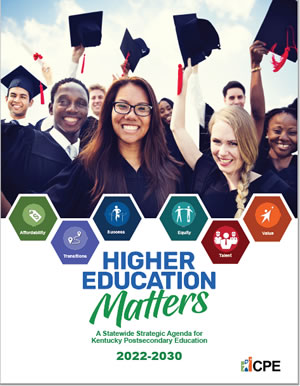Strategic Agenda for Postsecondary Education
A primary duty of the Council is the development and implementation of a strategic agenda, which aligns state and institutional goals and then sets the strategies by which these goals will be achieved and resourced.
Kentucky's Goal: 60% with Degrees and Credentials by 2030
The state goal is to raise the percentage of Kentuckians with a high-quality postsecondary degree or certificate to 60 percent by the year 2030. Achieving this goal is critical to accelerate job creation, grow the economy, and expand the tax base through the contributions of a more skilled, productive workforce.
Kentucky's strategic agenda for higher education considers all the factors that contribute toward Kentucky increasing educational attainment, and setting priorities, objectives and key performance indicators to ensure progress toward that goal.
Agenda Publications
- 2022-2030 Strategic Agenda (June 2025 midterm revision)
- 2022-30 Strategic Agenda (Aug. 2022)
- 2016-21 Strategic Agenda
Guiding Legislation
2022-30 Strategic Agenda

Development of the Council's statewide strategic agenda for 2022-30, "Higher Education Matters," relied upon the valuable insight and direction of many constituencies and committees, including CPE board members, higher education leaders, faculty members, students, K-12 educators, legislators, employers and partners. Based on this feedback, the agenda is focused on five priority areas:
- Affordability: Making postsecondary education accessible and affordable for all Kentuckians.
- Transitions: Helping more students enter college prepared to succeed.
- Success: Enabling more students to earn high-quality degrees and credentials.
- Talent: Growing talent and innovation to support our communities, employers, and economy.
- Value: Strengthening public understanding that postsecondary education is key to opportunity and economic growth.

Priority: Affordability
Over the past two decades, federal and state disinvestment in public higher education has shifted the majority of college costs to students and their families. This shifting of responsibility has put more of the burden on students and their families. While Kentucky's campuses have tried to offset costs with increased institutional aid, stagnate growth in federal and state sources has resulted in marginal progress in average amounts of unmet financial need.

CPE will collaborate with elected leaders to increase state investment in postsecondary education and student financial aid, reducing the financial burden on students. We will also work to limit tuition and fee increases, while expanding efforts to help incoming students navigate the complexities of college pricing—including the role of grants, scholarships, and responsible borrowing in managing costs.
Objectives
- Reduce financial barriers to college enrollment and completion.
- Improve the public’s understanding of how to pay for college.
Key Performance Indicators
- First-time, In-state Student Unmet Need (State- and Campus-Level): The total cost of attendance (tuition, fees, room and board, transportation, textbooks and other costs) for an academic year minus Student Aid Index or SAI (formerly Expected Family Contribution or EFC) and all financial aid, excluding loans.
- Debt at Graduation (Contextual Metric): The sum of loans taken from the year of first enrollment to the highest undergraduate credential earned.

Priority: Transitions
Nationally, the percentage of high school seniors enrolling directly in college has been declining over the past decade. Kentucky's in-state college-going rate has seen a double-digit decline, from 55.1% in 2015 to 48.1% in 2023.

It is unrealistic to expect high school guidance counselors alone to help every student navigate the complex landscape of college admissions. This burden is amplified by the growing number of students taking advantage of Kentucky’s dual credit opportunities before college. In response, CPE will work with partners to advocate for dedicated college coaches and advisors in every school district, and to develop resources that guide students and families step by step through the planning and application process.
Objectives
- Increase students’ readiness to enter postsecondary education.
- Increase college-going rates and enrollment in postsecondary education.
Key Performance Indicators
- Undergraduate Enrollment (State- and Campus-Level): Total unduplicated number of students who enroll in an undergraduate program in an academic year, either full-time or part-time.
- Immediate College-Going Rate (State-Level): Percent of recent Kentucky high school graduates who attend any in-state or out-of-state postsecondary institution in the summer, fall or spring following high school graduation.
- FAFSA Completion (Contextual Metric): Percent of high school seniors who complete the FAFSA in an academic year.

Priority: Success
Kentucky’s colleges and universities are making impressive gains in retention and completion. However, while institutions are narrowing gaps, more progress is needed to close them. For example, while the overall six-year graduation rate for all public university students is currently 61.2%, the rate for low-income students is only 49.2%.

Increasing degree production for everyone is an overriding concern of this agenda, but we are not prioritizing quantity over quality. From certificates to doctorates, we must ensure students master the content, skills and mindsets necessary for future success and fulfillment. The challenge is producing quality credentials at a pace commensurate with our overarching attainment goal.
Objectives
- Increase persistence in and timely completion of postsecondary programs.
- Maximize transfer of academic and experiential credit.
- Ensure academic offerings are high-quality, relevant and inclusive.
Key Performance Indicators
- Undergraduate Degrees and Credentials (State- and Campus-Level): Total degrees and credentials awarded by public universities and KCTCS institutions.
- Graduation Rate (State- and Campus-Level): The percent of first-time, full-time credential-seeking students receiving a bachelor’s degree within six years at public universities, or an associate degree or credential within three years at KCTCS from their starting institution.
- Two-Year to Four-Year Transfer (Sector Level): Percent of first-time, full-time credential-seeking students entering KCTCS in the fall who transfer to any in-state, four-year public institution within three years of entry.
- Retention Rate (State- and Campus-Level): Percent of first-time, credential-seeking students enrolled in the summer or fall who return to the same institution the following fall.

Priority: Talent
A primary purpose of postsecondary education is to produce adaptive, highly skilled workers to fuel the economy. A 2021 report by the Kentucky Chamber of Commerce estimates that the state has 90,000 to 100,000 job openings in any given month, and 65% to 85% of these vacancies require training, credentialing or degrees beyond high school.
Kentucky must expand postsecondary access to undereducated, working-age adults to fill critical work shortages in healthcare, STEM fields, early childhood development and other high-demand areas.
Objectives
- Improve postsecondary education's responsiveness to and alignment with current and projected workforce demands.
- Guide investments in research, training and scholarships to support innovation and growth
Key Performance Indicators
- Graduate and Professional Degrees (State- and Campus-Level): Total number of graduate/professional degrees awarded in an academic year.
- Statewide Educational Attainment Goal (State-Level): Percent of Kentuckians ages 25-64 with a postsecondary credential (certificate or higher).
- Graduates Working or Pursuing More Education (Contextual Metric): Percent of certificate, associate and bachelor’s degree graduates working in Kentucky or pursuing additional education one year following graduation.
- Institutional Degree Premium (Contextual Metric): Average wage of in-state postsecondary graduates by degree level compared to the state median.

Priority: Value
Increasingly, Americans are questioning the value of higher education. The extent of this skepticism varies according to socioeconomic status, political party affiliation, geographic region and other factors.
A 2021 survey conducted by the American Association of American Colleges and Universities and the Bipartisan Policy Center asked adults whether college was definitely or probably still worth it. Overall, only 27% of respondents believed college was definitely worth it; another 33% said it probably was.
Negative beliefs about the value of college, though widespread, are based more on feeling than fact. College’s return on investment in strict financial terms depends on how much you paid for your degree and the marketability of your chosen field. Some students reap greater financial rewards than others.
It is our hope that increasing higher education’s value proposition will lead to greater investment from both the General Assembly and the private sector. More profoundly, it will restore our belief in higher education’s ability to put Americans on a path to future prosperity and fulfillment.
Objectives
- Increase public's belief in the transformative power of postsecondary education.
- Build support for greater investment in postsecondary education.
Key Performance Indicators
- State General Fund Appropriations: Percent change in net general fund appropriations for full-time equivalent students, excluding state financial aid or state monies for debt service.
- Economic Mobility: Proportion of low-income students who are earning salaries above the 50th percentile of Kentucky wages within three years of graduation.
Last Updated: 6/30/2025
